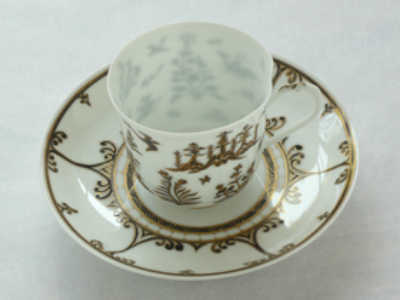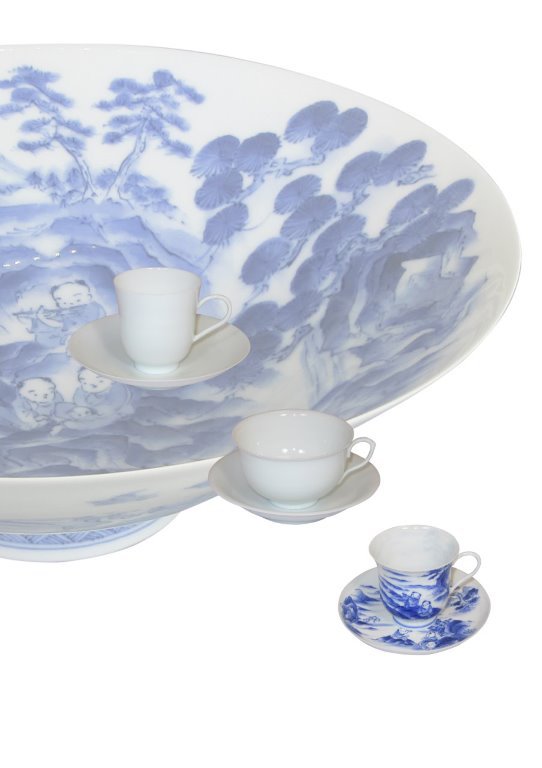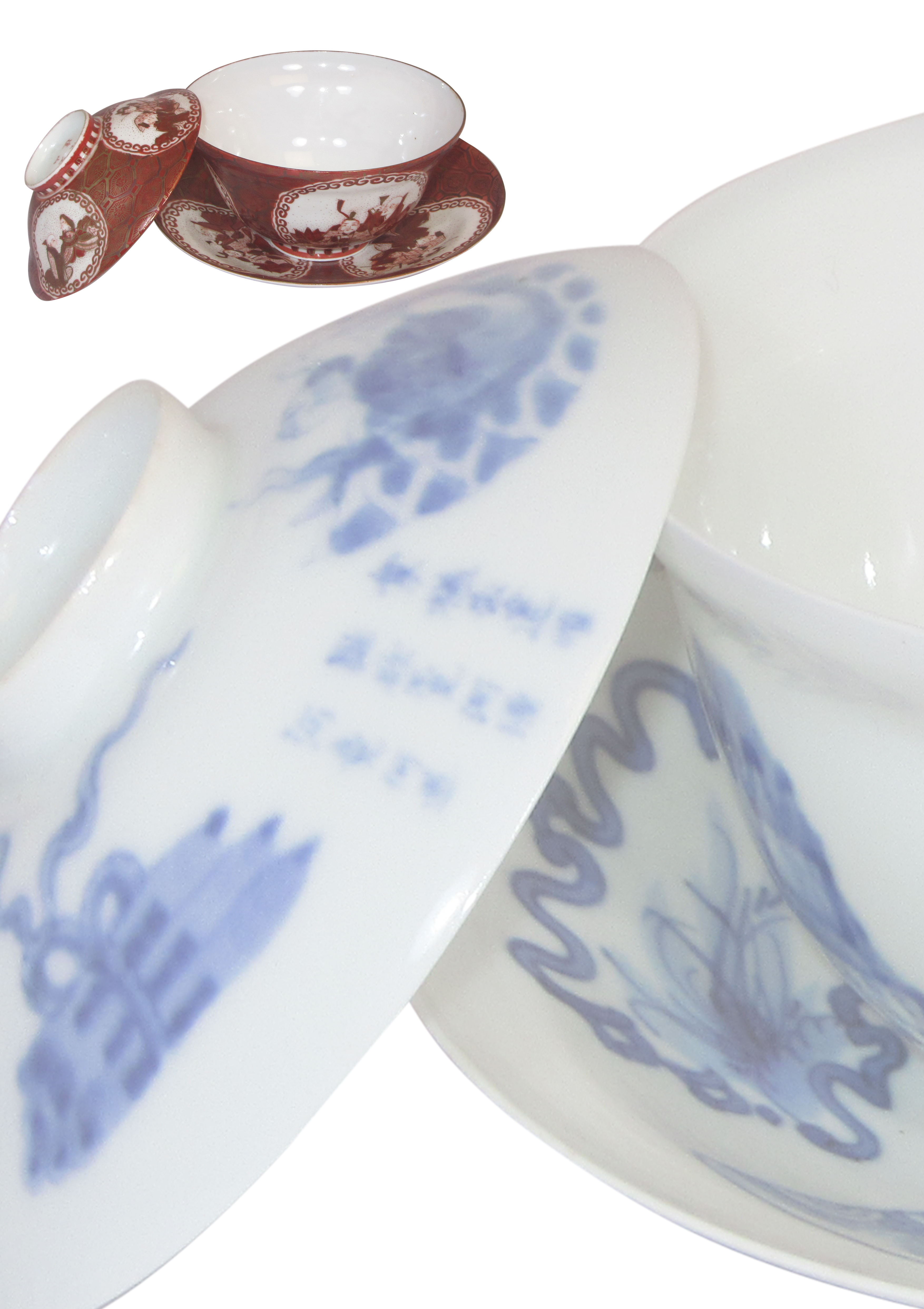卵殻手(らんかくで)

平戸・三川内焼の卵殻手は、ヨーロッパ各地の博物館などに広汎に収蔵されおり、非常に人気の高い製品であったことがうかがえます。卵殻手とは、きわめて薄く軽い磁器で、生地は純白で描かれた模様が透けて見え、手取りは軽くその重さを感じないほどです。


歴史
江戸時代後期(1800年初め)、平戸藩主の命を受けて、極薄手の最高級磁器が三川内の平戸藩御用窯で焼かれました。その器は大変薄く軽く、まるで卵の殻のようであることから、海外では『エッグ・シェル』と呼ばれました。
非常に高度な技術を要し、原材料も平戸藩領内に産出する「網代陶石」を使用するなど、ごく一部の名工だけしか作り出せなかったそうです。長崎出島に寄港したオランダ人の目にとまり、最高級の貿易品として珍重されました。この時に製造された器は、日本においてはじめて製造されたコーヒーカップであり、また海外貿易の率先であったと資料に記されています。明治時代には万国博覧会へも数多く出品され、現在もアメリカやヨーロッパの博物館に所蔵されています。
輸出の経緯
1830年頃から、卵殻手最高級磁器がの輸出が開始されました。平戸藩は平戸焼の輸出に積極的に取り組む体勢を整え、平戸焼物産会所を長崎に開設し、輸出用平戸焼の受注から販売までを管理していました。平戸焼物産会所は単独の組織ではなく、平戸藩蔵屋敷の中に設けられた平戸焼輸出を担当する一部門であったそうです。
ヨーロッパ向け輸出の主力商品として、平戸焼の卵殻手は盛況でした。イギリスの有力新聞タイムズ紙では、1845年に卵殻手に関する記事が初めて登場し、それ以降頻繁に掲載されるようになりました。
また、幕末に来日した外国人が著した旅行記からも。江戸期のヨーロッパにおける卵殻手の需要と認識の実態について知ることができます。いずれも長崎訪問時に卵殻手に接したこと、あるいは購入したことを記しており、日本の卵殻手が既にヨーロッパに広く認識されておいたことや、その品質の高さを誰もが認めているといった当時の実態を知ることが出来ます。
現代の卵殻手
時代の変化に伴い、需要の減少から受け継ぐ職人もいなくなり、1900年頃にはその技法は途絶えてしまいました。13代目平戸藤祥は若き日に、当家に残る伝来の極薄手磁器に心動かされ、卵殻手の謎に取り組みました。再現にあたっては、平戸松浦家にゆかりの顧問所にある古文書を読み解いていきました。しかし、門外不出の極秘の製法であったため、その製造方法についての記録はほとんど残されていませんでした。藤本氏は、高齢の先達に過去の記憶を尋ねることで、その技法を模索しました。
技法のみならず、その材料も重要な要素です。その一つである「網代陶石」の採取は既に途絶えていました。藤本氏は行政に申請をし、針尾島を陶石の専門家と共に調査を行い、ついに先人が採取した洞窟跡を探し出し、網代陶石を見つけ出しました。この網代陶石を調合することにより、粘性が高まると同時に生地が割れにくく強靭となり、極限まで薄い陶磁器の製造が可能となるのです。製造は手轆轤(ろくろ)で成形し、そののちに薄く削り上げていきます。光の透け具合をみながら削り具合を確認していきますが、江戸時代においても蝋燭の明かりでその薄さを確認しながら製造していたことが資料に記載されています。
このようにして100前に途絶えた幻の卵殻手は藤本氏によって2006年に再現されたのです。三川内には連綿と受け継いだ技法をつないできた窯元達が、国内のみならず、国際的な認知度を高めるために後継者の育成、博覧会への参加、新しい技術や意匠の開発など、様々な挑戦と努力を続けています。

Eggshell Porcelain Ware
Many museums in Europe preserve the eggshell porcelain ware produced in Mikawachi, Hirado. It can be inferred that the product was highly appreciated in Europe from this fact. The eggshell porcelain is extremely thin and light-weight pure white porcelain ware whose painted decorations on the front surface are seen through the back face. The lightness allows us to scarcely feel the weight.


History
In the late Edo period (early 1800s), the Mikawachi purveying kilns to the feudal government received an order from the Hirado feudal lord to fire the extremely thin and highest quality porcelain ware. The ware was weightless and looked like the eggshell and thereby was named “eggshell” overseas.
The production of eggshell porcelain required sophisticated techniques. Only a few master potters were capable of this using special materials such as Ajiro pottery stone mined in Hirado domain. The eggshell porcelain attracted attention from the Dutch who came to Dejima in Nagasaki, which was then Japan’s only trading site with Dutch traders, and became a highest-grade trading item. The porcelain ware produced at that time was the first coffee cups made in Japan, and it was recorded that it pioneered in foreign trade. The eggshell porcelain ware was exhibited in world expositions in the Meiji period (1868-1912), and masterpieces are housed in museums in the U.S. and Europe today.
Export of Eggshell Porcelain Ware: Background
Export of the eggshell porcelain ware began around 1830s. The Hirado feudal government developed a system to actively export Hirado ware and established a trading office for Hirado ware in Nagasaki to manage the business from order reception for export to sales. The trading office was not a single organization but a function in the Hirado government to be in charge of exporting business.
Hirado eggshell porcelain ware was in high demand in Europe as a top-selling import item. Times, an English quality paper, published the first article about the eggshell porcelain in 1845, and the newspaper frequently covered it afterwards.
Some travel journals written by foreign visitors to Japan towards the end of Edo period allow us to know the actual demand for and recognition of eggshell porcelain ware in Europe. The journals describe that the writers saw or purchased the ware when they visited Nagasaki. From those facts, we can learn the eggshell porcelain ware made in Japan was widely recognized in Europe and its excellent quality was highly praised by Europeans.
Eggshell Porcelain Ware Today
As time passed, fewer potters who produced eggshell porcelain ware remained due to a change in demand, and the production methods were eventually lost around 1900.
Pieces of paper-thin eggshell porcelain ware handed down in the Fujimoto family motivated young Hirado Tousyo the 13th to restore the production methods. He started with researches on ancient documents that Matsura family of lord Hirado retained but the methods were not recorded because they were never allowed to be passed down excepting the potter families in Mikawachi. Fujimoto searched the ways to restore the lost production and asked aged potters to remember old days in Mikawachi for the methods.
Not to mention the techniques, materials were key elements for production. Ajiro pottery stone, one of the materials and a secret for the production, was not mined any longer. Fujimoto made an official application to obtain a permission for mining and researched with some experts, and finally he located the old mining site in a cave on Hario Island, where his predecessors mined the stone. Blending porcelain clay made out of Ajiro stone enhances plasticity and makes porcelain stronger to prevent the wares from breaking easily, which enables its paper-thin bodies.
The eggshell porcelain ware is formed by hand throwing on a wheel and then trimmed until the body becomes thin. Checking the thinness with penetrating light is necessary for this trimming process. The ancient records describe that the potters in Edo period used candle light to check thinness of the bodies while they were trimming the eggshell porcelain ware.
In 2006, Fujimoto succeeded in recreation of eggshell porcelain ware for the first time since the last piece had been fired 100 years ago. In Mikawachi, kiln owners have inherited production techniques and skills from generation to generation and made efforts and challenges to increase awareness of Mikawachi ware, both domestically and internationally, through successor training programs, participation in exhibitions and development in new technologies and designs.

